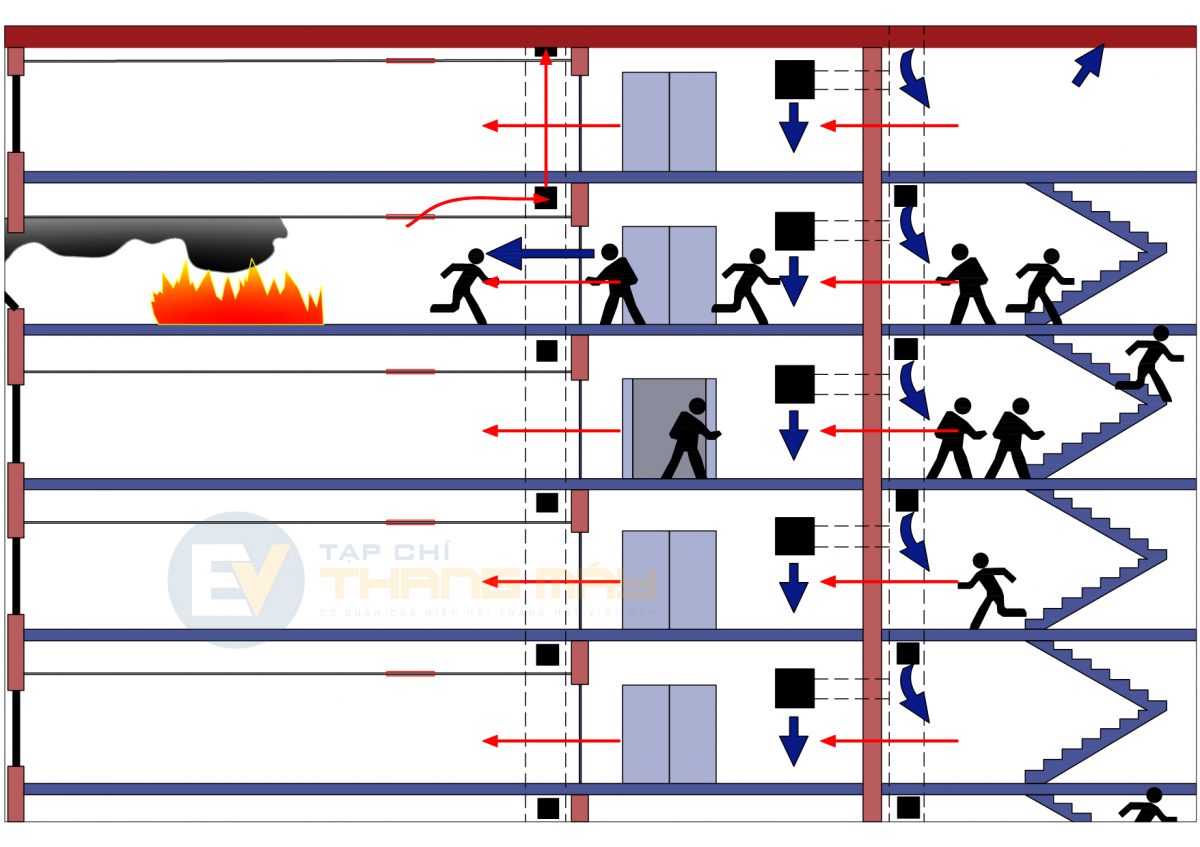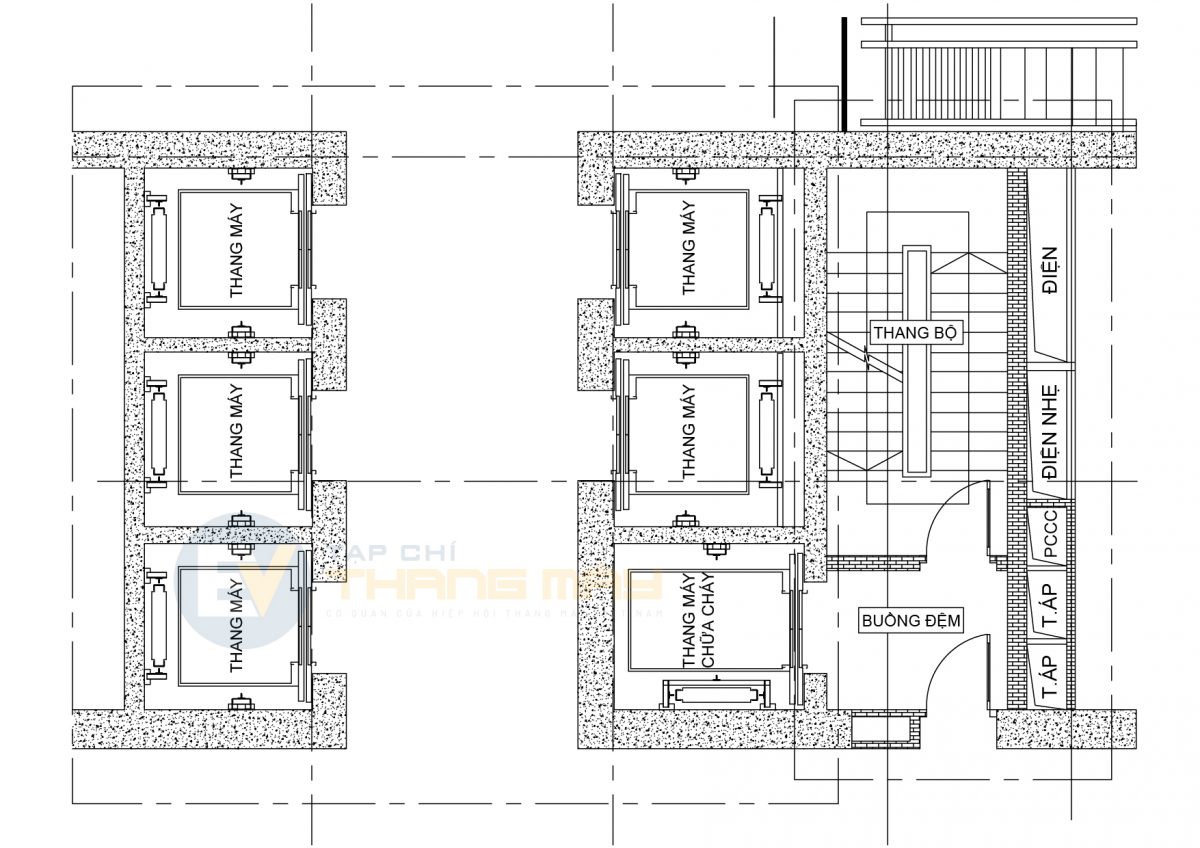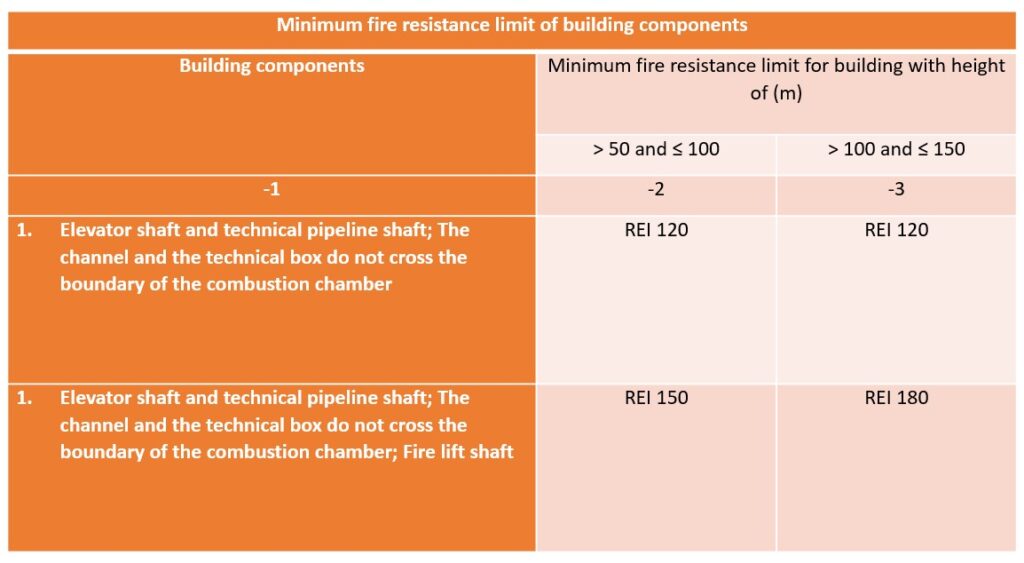The increase in the number of high-rise buildings has a great impact on fire prevention and rescue. One of the solutions that requires strict technical requirements is the fire elevator.
Regulations on fire prevention and fighting related to elevators are specified in Circular 02/2021/TT-BXD promulgating QCVN 06:2021/BXD national technical regulation on fire safety for buildings. Accordingly, there will be regulations on conditions of buildings that need to install fire elevators, technical requirements, space layout, etc. related to fire elevators.
First, we need to understand the concept of fire elevator: “Elevator is installed primarily for the transport of people but is equipped with additional protective control systems, communications and signs to allow those elevators to be used under the direct control of the fire brigade to reach the floors of the building when a fire occurs.”
In Clause 3 on Ensuring safety for people, it is stated: In the space of stairshafts, except for those without smoke, it is allowed to arrange no more than two lifts carrying people down to the first floor only with the following results: structure covering the shaft made of non-combustible materials.
Shaft located outdoor, if needing to be covered, must use structures made of non-combustible materials.
In Clause 4 on preventing fire spread, it is stipulated that:
– Covering structures of shaft (except for those mentioned in Clause 3, Article 4.6) and elevator machine rooms (except roof rooms), as shaft as of channels, shaft and electrical cabinet must meet the requirements set forth as for type 1 fire partitions and type 3 fire-blocking floors. The fire resistance limit of the covering structures between the elevator shaft and the elevator’s machine room is not specified.
When it is not possible to install fire doors in the structures covering the above-mentioned lift shafts, buffer spaces or halls with type 1 fire partitions and type 3 fire-blocking floors or automatic closing screens must be arranged. the openings of the shafts in case of fire. These screens must be made of non-combustible materials and their fire resistance limit is not less than E 30.
In buildings with smoke-free stairshafts, automatic anti-smoke protection must be arranged for shaft which exits do not have fire-blocking buffer compartments with positive air pressure when burning.
In basements or semi-basements, in front of the entrance to the elevators, there must be type 1 fire-blocking buffer compartments with positive air pressure when burning.
In Clause 6 on Fire fighting and rescue provides:
– Houses and building must ensure fire fighting and rescue by solutions: structure, layout – space, engineering – works and organizational solutions.
The arrangement and installation of fire fighting elevators must ensure the following basic provisions:
+ It is not allowed to use elevators mainly for transporting goods as fire-fighting elevators.
+ Under normal conditions, fire elevators are still used to carry people. Fire elevators can be arranged with a separate elevator lobby or in a common lobby with passenger elevators and combined by a group automatic control system.
+ Having a calculated number sufficient so that the distance from the location of those elevators to any point on the floor plan that it serves does not exceed 60m.
+ If there is only one fire-fighting elevator, that elevator must reach at least all floors adjacent to the floor that have fire.

Access and use of elevators for fire fighting
+ If there are many fire-fighting elevators arranged in one shaft, the elevators can serve different areas of the building, provided that the service area on each of those elevators must be clearly indicated.
+ In all cases, the service form of the fire elevators must be the same and common, for example, the elevator only serves odd floors or even floors or all floors.
+ If there are evacuation floors, each floor must be serviced by at least one fire-fighting elevator.
+ In the normal operation mode, the doors of the fire-fighting elevators must not open to those evacuation floors, and the landing doors of the shafts at those evacuation floors must be locked regularly and can only be unlocked automatically when switch to fire service mode.
+ In case of fire, the firefighting lifts must ensure that the firefighter:
> is the only person who has the right to control and operate to access the fire with his equipment easily, familiarly, safely and quickly.
> protected from the effects of fire and smoke by appropriate solutions, especially when exiting such lifts.
> have clear and safe passage for access to such lifts and to the floors served by such lifts.
> do not have to move more than two floors to reach any floor that can be burned.
+ Protected in separate elevator shafts (not shared with other types of elevators) and in each such elevator shaft, there are only 3 fire-fighting elevators arranged. The structure surrounding the lift shaft must have a fire resistance rating of not less than REI 120.
+ The fire elevator lobby is a buffer compartment that ensures all of the following regulations:
> has an area not less than 4m2;
> when combined with the landing staircase without smoke, the area is not less than 6m2;
> surrounded by class 1 fire partitions;
> installed water supply waiting DN 65 for professional fire force;

Fire elevator shares buffer room with escape stairs
+ The arrangement of fire fighting elevators must be able to estimate the travel path of the professional fire fighting team and ensure that the fire fighting team can access all rooms on all floors of the building.
+ The carrying capacity of fire fighting lifts must not be less than 630 kg for apartment buildings of group F1.3 and not less than 1,000 kg for manufacturers and other public buildings.
+ The moving speed of the fire-fighting elevator must not be less than H/60 (m/s), where H is the lifting height (m).
+ The covering structure of the fire-fighting elevator cabin must be made of non-combustible or weakly combustible materials.
– All indoor basements with 2 to 3 basements must be equipped with a two-way emergency communication system between the fire control room and necessary areas, including the fire elevators. .
Additional regulations on fire safety for some specific groups of buildings
For some specific groups of buildings, there are also additional regulations for fire elevators and related parts, specifically:
– The elevator landing must be separated from the corridors and adjacent rooms by fire partitions with fire resistance limits as prescribed in A.2.24.
The material of the elevator car parts shall be constructed as the fire elevator.
– Fire elevators must be arranged in separate shafts with independent elevator halls. The exit from this elevator to the outside of the building is not arranged through the common hall.
The number of fire elevators for each fire compartment must be calculated enough so that the distance from the location of those lifts to any point on the floor plan that it serves does not exceed 45m.
Components enclosing the fire-fighting elevator cabin (walls, floors, ceilings, doors) must be made from non-combustible materials or from material group Ch1.
Surface finishing tiling materials of cabin enclosing members are applied as for rooms as specified in A.2.25.
– The fire resistance limit of the elevator shaft structure and the elevator’s engine room is taken as prescribed in A.2.24.

(REI is the fire resistance rating of a structure or object. When it comes to REI, it means its ability to withstand fire and temperature. For example, REI 120, means the object’s ability to withstand fire is limited to 120 minutes.)
– The doors of the elevator landing and the doors of the elevator’s machine room must be air- and smoke-free doors.
– Electrical system: The electricity supplied to technical equipment systems, including fire-fighting elevators, must ensure the maintenance of such equipment for a period of not less than 3 hours from the time fire occurs and must be obtained from 3 independent power supplies.
– The elevator shafts of the apartment part are not connected to the rest of the building. Technical system shafts (including garbage pipes) of the apartment and the rest of the house must be separate.
– The smoke protection for the house, fire alarm system and automatic fire fighting shall comply with the additional regulations below:
– The automatic fire alarm system must clearly indicate the address of each apartment. In the rooms of the apartment and the corridors of the floors, including the elevator landing, smoke detectors must be installed.
– It is necessary to equip fire alarm systems, equipment, automatic fire fighting means in channels, electrical engineering shafts, communication and other technical shafts with fire danger.
– The power supply for the fire protection system includes: elevators for transporting firefighter and fire fighting vehicles; smoke protection system; fire alarm system, automatic fire fighting; must be taken from independent electrical cabinets or separate electrical panels with different paint colors along two separate routes to the distribution equipment of each fire compartment.
Regulations on protection against smoke in areas associated with elevators
– The protection against smoke must supply air from outside into areas including:
+ In elevator shafts (when it is not possible to support air supply to buffer chambers in case of fire) in houses with smoke-free elevator chambers
+ In the buffer compartment of the fire-fighting elevator.
+ In buffer spaces in front of elevators (including elevators) in basements and semi-basements.
– The air supply flow used for smoke protection should be calculated to ensure that the air pressure is not lower than 20Pa at the following locations:
+ The lower part of the elevator shaft when the doors to the elevator shaft are closed on all floors (except the bottom floor).
+ Buffer compartments on fire floors in buildings with non-smoke staircases of class N3, when the entrance to the corridor or lobby in basements, elevator waiting room and the buffer compartments in front of the elevator has an open door, and on all other floors the doors are closed.
– When calculating the parameters of the incoming air supply system, the following must be taken into account:
+ Residual air pressure not lower than 20Pa and not more than 50Pa – in shafts.
+ The car are connected to the landing and when the elevator doors on the floor are left open.
Luu Hien Minh



